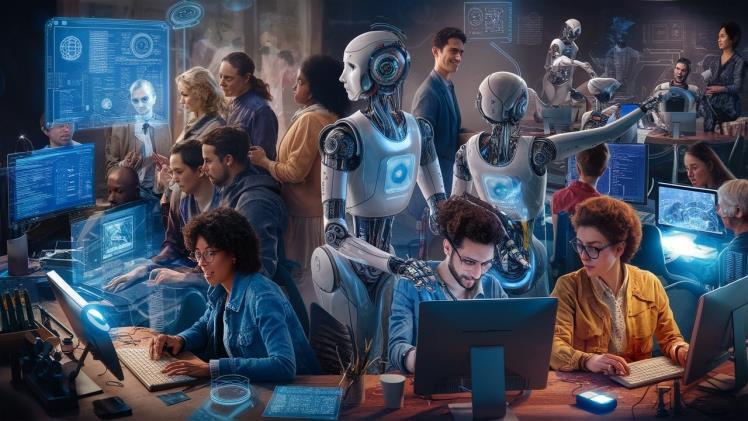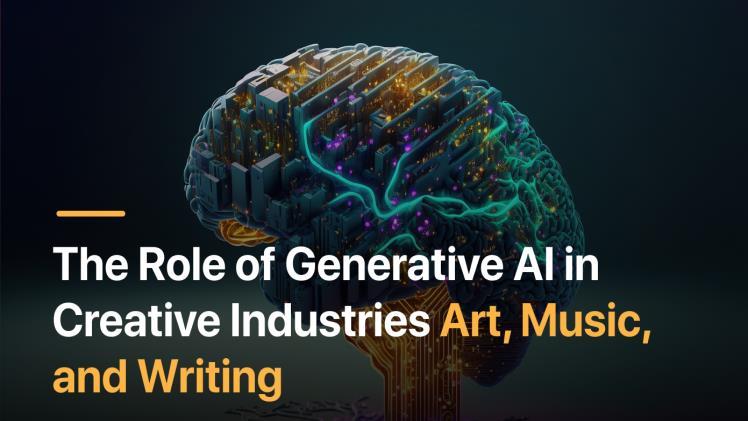Introduction
Generative AI is not just a technological breakthrough—it’s a cultural shift redefining creativity. In recent years, artificial intelligence has evolved from a tool of automation to a co-creator in human expression. Nowhere is this transformation more apparent than in the fields of art, music, and writing, where generative AI is blurring the line between machine logic and human imagination. From AI-powered brushes and digital symphonies to stories written by algorithms, the creative world is undergoing a profound reimagining.
What Is Generative AI?
Generative AI refers to a subset of artificial intelligence that can generate new content by learning from existing data. It uses models like Generative Adversarial Networks (GANs), transformers, and diffusion models to produce outputs such as images, text, and audio. These systems are trained on massive datasets and can imitate, remix, and even innovate on learned patterns.
1. Generative AI in Art
AI as the New Brush
Tools like DALL·E, Midjourney, and Runway ML have transformed how digital art is created. Artists can now use text prompts to generate entire scenes, experiment with styles, and produce complex visuals in seconds —sometimes even enhancing these compositions with this background maker to fine-tune the final presentation or add atmospheric depth.
- Case Study: In 2023, an AI-generated artwork titled Théâtre D’opéra Spatial won first prize in a digital art competition, sparking debate about AI’s role in art.
- Application: Visual artists use AI to brainstorm compositions, create mood boards, or finish incomplete sketches.

The Debate: Originality vs. Algorithm
Critics argue that AI lacks true creativity—it synthesizes but doesn’t originate. However, proponents see it as a collaborative tool, much like a camera or Photoshop, expanding rather than replacing human artistry.
2. Generative AI in Music
From Notes to Neural Networks
AI-driven platforms like Amper Music, AIVA, and Google’s MusicLM can compose music in various genres, moods, and structures. These tools analyze vast audio datasets to generate melodies, harmonies, and rhythms.
- Use Cases:
- Background music for video games and films.
- Soundtracks for indie creators without budgets for live composers.
- Experimental genres blending human and AI input.
Collaborations and Controversies
Major artists like Holly Herndon and Taryn Southern have collaborated with AI to produce entire albums. However, controversy surrounds AI tracks that mimic the voices and styles of real musicians—raising questions about consent and copyright.
3. Generative AI in Writing
Language Models as Co-Writers
Language models like ChatGPT, Sudowrite, and Jasper AI are revolutionizing writing. Whether it’s poetry, marketing copy, fiction, or even coding, generative AI assists writers in ideation, drafting, and editing.
- Novelists use it for overcoming writer’s block.
- Bloggers use it to optimize SEO content at scale.
- Screenwriters experiment with AI-generated plot twists.

Limits of Literary Intelligence
While AI can replicate grammar and mimic styles, it struggles with emotional nuance, context, and originality. Still, it’s a powerful partner in speeding up content creation and providing creative prompts.
Ethical Considerations
Copyright and Ownership
Who owns AI-generated content—the user, the tool’s developer, or the dataset owners? As laws lag behind tech, disputes have emerged around unauthorized use of copyrighted styles, especially in music and art.
Cultural Sensitivity
Generative models trained on biased datasets can unintentionally reinforce harmful stereotypes. Creators and developers must be vigilant in filtering outputs and improving training data.
The Human-AI Partnership
Rather than seeing AI as a competitor, many creatives embrace it as a collaborator. It provides inspiration, fills in technical gaps, and allows for experimentation beyond human constraints. The future lies in hybrid creativity—where human emotion meets machine precision.
Future Outlook
As generative AI evolves, expect to see:
- More personalized AI-generated content (e.g., custom songs or poems).
- AI tools embedded in traditional creative software (Adobe, Logic Pro, etc.).
- Entire industries reshaped—from digital marketing to film production.
Ultimately, the question isn’t whether AI can be creative, but how we choose to use its creativity. With careful guidance and ethical boundaries, generative AI has the potential to usher in a new golden age of human expression.
Conclusion
Generative AI is transforming the landscape of art, music, and writing by offering powerful tools to amplify creativity. While challenges remain—especially around ethics and originality—the technology is not a replacement for human expression, but an evolution of it. The artists of tomorrow may not just wield brushes or instruments—they’ll write code, train models, and collaborate with intelligent machines to create masterpieces unlike anything we’ve seen before.
FAQ: Generative AI in Art, Music, and Writing
1. What is generative AI?
Generative AI is a type of artificial intelligence that can create new content—such as images, music, or text—by learning patterns from existing data. It uses models like GANs and transformers to generate outputs based on prompts or input parameters.
2. How is generative AI used in art?
Generative AI tools like DALL·E and Midjourney allow users to create digital artworks by inputting text prompts. Artists can use these tools to explore new styles, generate concepts, or complete pieces more efficiently.
3. Can AI really create music?
Yes, platforms like AIVA, Amper Music, and MusicLM can generate original music tracks in various genres and moods. These tools are used in film scoring, video game soundtracks, content creation, and more.
4. How does AI assist with writing?
Language models like ChatGPT, Jasper, and Sudowrite help writers by generating text, suggesting edits, overcoming writer’s block, or brainstorming creative ideas. They’re used for fiction, blogging, screenwriting, and even poetry.
5. Is AI-generated content considered original?
This is a debated topic. While AI generates new combinations of data, it doesn’t create from personal experience or emotion. Many experts consider AI-generated content to be derivative, though it can be highly innovative when guided by human input.
6. Who owns AI-generated artwork or writing?
Ownership depends on the platform’s terms of service. Some tools grant rights to the user, while others retain partial ownership. Legal clarity around this issue is still evolving, especially regarding datasets that include copyrighted material.
7. Can AI replace human creativity?
No. While AI can mimic and assist creative processes, it lacks human emotions, intuition, and lived experience. Most see it as a collaborative tool that enhances, not replaces, human creativity.
8. Are there ethical concerns with generative AI?
Yes, concerns include copyright infringement, lack of credit to original creators, bias in training data, and the misuse of AI to imitate voices or styles without consent. Ethical AI development and responsible usage are essential.
9. Do artists and musicians support using generative AI?
Opinions vary. Some embrace it as a creative partner, while others fear it undermines originality and devalues human artistry. The debate is ongoing, especially in professional and academic circles.
10. What does the future of generative AI in the arts look like?
The future will likely involve greater collaboration between humans and AI, more sophisticated creative tools, and deeper integration of AI in education, entertainment, and content creation—provided legal and ethical issues are addressed.

